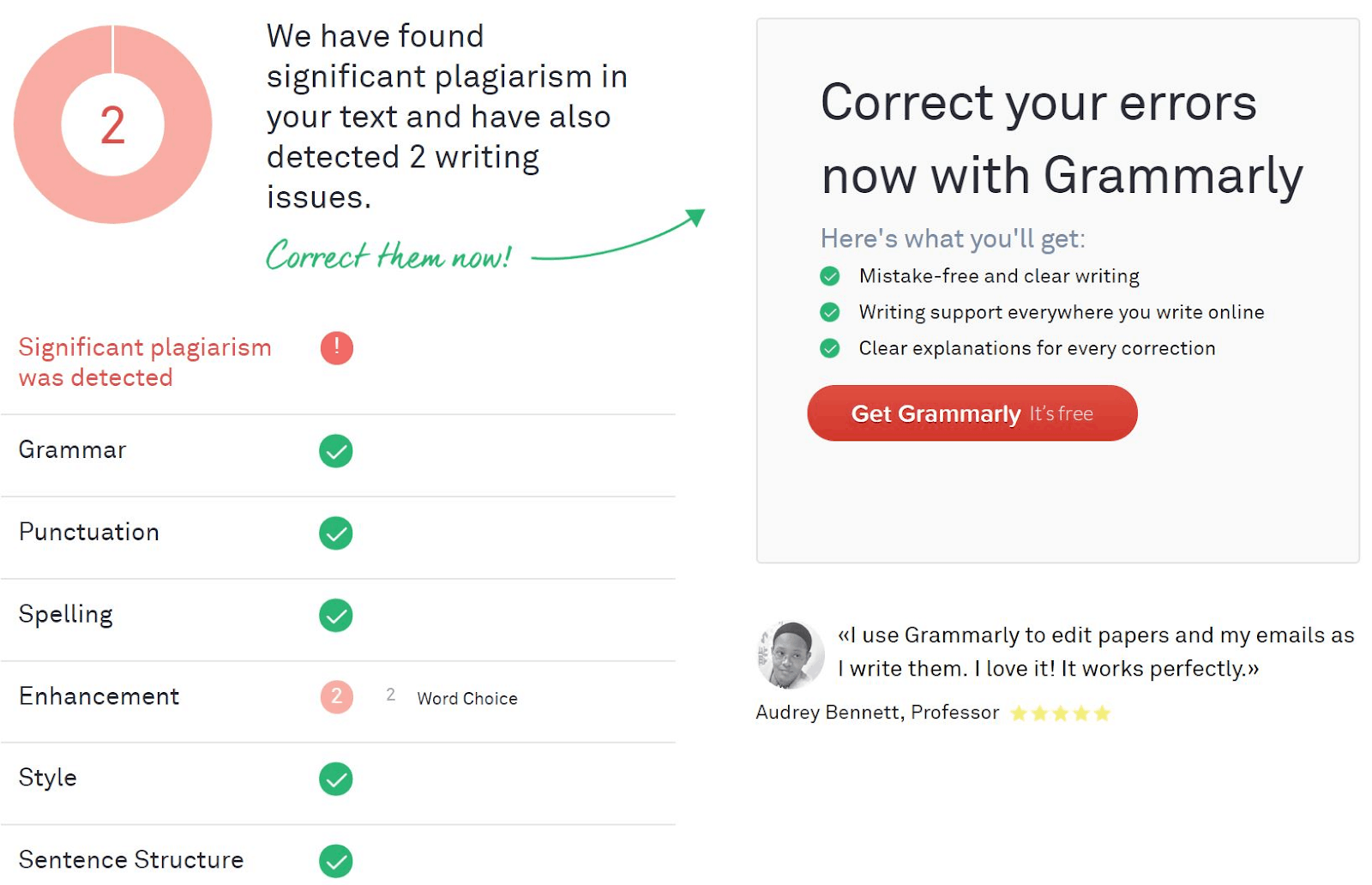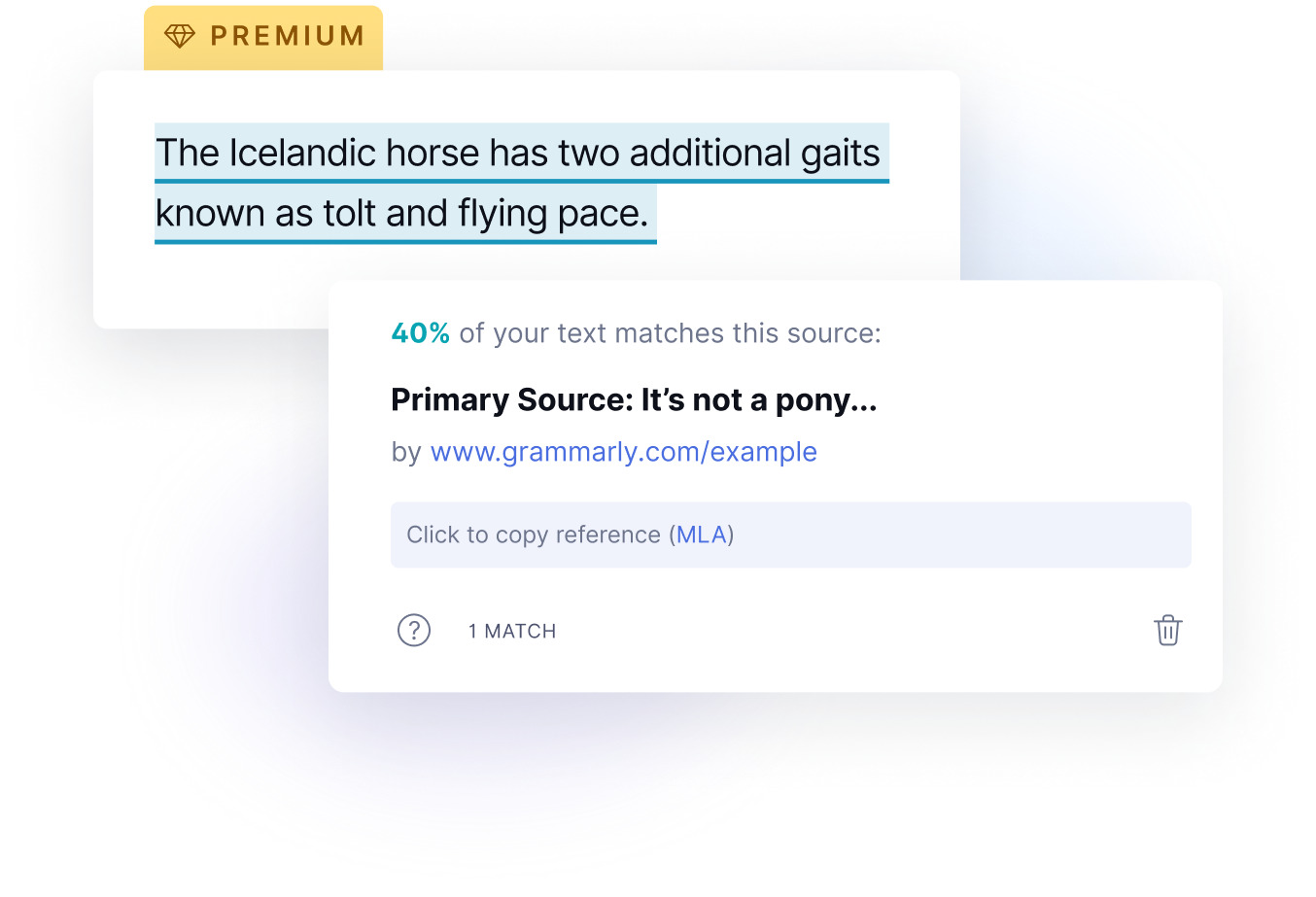Introduction
Welcome to the world of writing, where originality and integrity are highly valued. As a writer, it is crucial to ensure that your work is unique and free from any form of plagiarism. Thankfully, there are a multitude of tools available today to help with plagiarism detection, and one such popular tool is Grammarly Plagiarism Checker.
Grammarly Plagiarism Checker is a widely used online tool that helps writers, students, and professionals check their work for any instances of plagiarism. It is known for its accuracy and reliability, making it a go-to choice for many individuals.
In this article, we will delve deeper into the workings of Grammarly Plagiarism Checker and assess its accuracy. We will also explore the pros and cons of using this tool, as well as discuss factors that can influence its accuracy. Additionally, we will provide tips on how to improve the accuracy of Grammarly Plagiarism Checker.
By the end of this article, you will have a clear understanding of Grammarly Plagiarism Checker and its effectiveness in detecting plagiarism. So, let’s get started and uncover the truth behind this powerful tool!
What is Grammarly Plagiarism Checker?
Grammarly Plagiarism Checker is an advanced tool designed to help writers ensure the originality of their work. It is a feature offered by Grammarly, which is a popular online writing assistant known for its robust grammar and spell-checking capabilities.
The Plagiarism Checker feature of Grammarly scans your written content to identify any matching text from various sources available on the internet. It compares your work against a massive database of web pages, articles, and other submitted documents to detect instances of plagiarism.
Using artificial intelligence and machine learning algorithms, Grammarly Plagiarism Checker analyzes your text for similarities and provides you with a detailed plagiarism report. This report highlights any questionable or copied content, helping you identify passages that may need to be revised or cited properly.
Grammarly Plagiarism Checker offers both free and premium versions. With the free version, you can check your text for plagiarism and receive a basic report indicating the percentage of copied content found. However, the premium version provides more comprehensive and detailed results, offering enhanced accuracy and additional features.
The premium version of Grammarly Plagiarism Checker not only identifies plagiarism but also suggests improvements for sentence structure, vocabulary, and writing style. It provides guidance on paraphrasing and helps you avoid unintentional plagiarism by offering alternative wording for potentially problematic phrases.
Overall, Grammarly Plagiarism Checker is a powerful tool for writers who want to ensure the originality and integrity of their work. Whether you are a student submitting an essay, a professional crafting a report, or a content creator publishing articles online, Grammarly Plagiarism Checker can be an invaluable resource to help you maintain ethical and authentic writing practices.
How does Grammarly Plagiarism Checker work?
Grammarly Plagiarism Checker is a sophisticated tool that employs advanced technology to detect instances of plagiarism in your written content. It follows a multi-step process to provide accurate and reliable results.
When you submit your text to Grammarly Plagiarism Checker, the tool first breaks it down into smaller chunks, such as sentences or paragraphs. It then compares each chunk against its extensive database, which includes a wide range of online sources, academic papers, journal articles, and previously submitted documents.
The tool uses advanced algorithms and text-matching techniques to identify similarities between your content and the sources in its database. It takes into consideration various factors, including the structure, wording, and arrangement of sentences, as well as the uniqueness of the ideas presented.
Grammarly Plagiarism Checker provides you with a detailed report that highlights any areas of concern. The report gives you a percentage score indicating the amount of content that matches existing sources. The tool also flags specific sentences or passages that are found to be potentially plagiarized, making it easier for you to review and modify those sections.
In addition to detecting plagiarized content, Grammarly Plagiarism Checker offers suggestions for improving your writing. It provides recommendations for rephrasing sentences or using alternative vocabulary, which not only helps in avoiding plagiarism but also enhances the overall quality of your work.
It is important to note that Grammarly Plagiarism Checker does not make the final determination on whether a piece of content is plagiarized. Instead, it acts as a guide and alerts you to potential issues that need further examination. It is your responsibility as the writer to review the flagged sections and ensure the proper citation or revision of the content.
Overall, Grammarly Plagiarism Checker utilizes advanced technology to analyze your text and compare it against a vast database of sources. It provides you with a comprehensive report highlighting potential instances of plagiarism and suggests ways to improve your writing. By using this tool, you can enhance the originality and integrity of your work, giving you peace of mind as you submit your content.
Pros of Grammarly Plagiarism Checker
Grammarly Plagiarism Checker offers several benefits that make it a valuable tool for writers, students, and professionals alike. Let’s explore some of the key advantages:
- Accurate Detection: Grammarly Plagiarism Checker employs advanced algorithms to effectively detect instances of plagiarism. It compares your text against a vast database of sources, ensuring comprehensive coverage and accurate results.
- Detailed Reports: The tool provides detailed reports that highlight the specific areas in your text where potential plagiarism is detected. It not only identifies the matching content but also suggests alternative wording and provides recommendations for improvement.
- User-Friendly Interface: Grammarly Plagiarism Checker has an intuitive and user-friendly interface, making it easy for users to navigate and interpret the results. The tool presents the plagiarism report in a clear and organized manner, allowing you to quickly identify and address any flagged content.
- Wide Range of Sources: The extensive database used by Grammarly Plagiarism Checker includes a diverse range of sources, including web pages, articles, academic papers, and previously submitted documents. This ensures comprehensive coverage and increases the chances of detecting potential plagiarism.
- Integration with Grammarly Writing Assistant: Grammarly Plagiarism Checker seamlessly integrates with Grammarly’s powerful writing assistant, providing users with a comprehensive suite of writing tools. This integration allows you to check for plagiarism while simultaneously benefiting from Grammarly’s grammar and spell-checking capabilities.
- Time-Saving: Using Grammarly Plagiarism Checker saves you valuable time by quickly identifying potential plagiarism in your text. It eliminates the need for manual searching and comparison, allowing you to focus on improving your content rather than spending hours on plagiarism detection.
These advantages make Grammarly Plagiarism Checker a valuable tool for ensuring the originality and integrity of your work. By utilizing this tool, you can have confidence in the authenticity of your writing and maintain ethical writing practices.
Cons of Grammarly Plagiarism Checker
While Grammarly Plagiarism Checker offers numerous benefits, it’s important to examine its limitations as well. Let’s explore some of the potential downsides to be aware of:
- Limited Database: Although Grammarly Plagiarism Checker has an extensive database, it may not include every possible source of content on the internet. It is possible for some lesser-known or niche sources to go undetected, leading to false negatives or incomplete plagiarism reports.
- No Offline Detection: Grammarly Plagiarism Checker requires an internet connection to function. This means that if you’re working on a document offline or your internet connection is unstable, you won’t be able to use the tool effectively.
- Overlapping Phrases: There may be cases where Grammarly Plagiarism Checker flags certain phrases or sentences as potential plagiarism, even if they are commonly used or originate from public domain sources. This can lead to false positives and require additional review to determine if the content is indeed plagiarized.
- Quality of Sources: The database used by Grammarly Plagiarism Checker includes a wide range of sources, including web pages and articles of varying quality. Some sources may contain inaccuracies or outdated information, which can impact the accuracy of the plagiarism detection process.
- Manual Review Required: While Grammarly Plagiarism Checker provides a detailed report highlighting potential instances of plagiarism, it is ultimately up to the writer to review and analyze the flagged content. This requires additional effort and attention to ensure proper citation or revision.
- False Sense of Security: Relying solely on Grammarly Plagiarism Checker to detect plagiarism can create a false sense of security. It is still essential for writers to develop their own plagiarism awareness and understanding to avoid unintentional plagiarism and maintain academic or professional integrity.
It is important to keep these limitations in mind when using Grammarly Plagiarism Checker. While the tool can be a valuable resource, it is not infallible and should be used as a supplement to your own knowledge and writing practices.
Accuracy of Grammarly Plagiarism Checker
The accuracy of Grammarly Plagiarism Checker, like any plagiarism detection tool, depends on several factors. While it is known for its reliability and effectiveness, it is important to understand the limitations of the tool and the variables that can influence its accuracy.
Grammarly Plagiarism Checker utilizes advanced algorithms and an extensive database to compare your text against existing sources. It analyzes the structure, wording, and arrangement of sentences to identify potential instances of plagiarism. However, it is important to note that the tool functions based on patterns and matches, rather than absolute proof of plagiarism.
The accuracy of Grammarly Plagiarism Checker can be affected by factors such as:
- Database Coverage: The comprehensiveness and diversity of the database used by Grammarly Plagiarism Checker play a significant role in its accuracy. A larger and more up-to-date database increases the chances of detecting instances of plagiarism.
- Originality of Content: The tool’s accuracy can be influenced by the originality of the content being analyzed. If the text contains little to no unique content, or consists mainly of widely used phrases or public domain information, it may yield false positives or overly cautious results.
- Paraphrasing and Synonyms: Grammarly Plagiarism Checker relies on sophisticated algorithms to identify variations and similarities in text. However, it may not always detect instances of paraphrasing or the use of synonyms effectively, leading to potential false negatives.
- Contextual Understanding: Grammarly Plagiarism Checker focuses primarily on the textual patterns and matches. While it can identify verbatim matches, it may not fully capture the contextual understanding required to differentiate between intentional plagiarism, unintentional repetitions, or commonly used phrases.
- Quality and Relevance of Sources: The accuracy of the tool can also be influenced by the quality and relevance of the sources in its database. Outdated or incorrect information in the database can potentially affect the detection process and accuracy of the results.
It’s important to remember that Grammarly Plagiarism Checker is a tool that assists in identifying potential instances of plagiarism, but the final responsibility lies with the writer to review and make necessary revisions. The tool serves as a guide and a starting point for further investigation.
While Grammarly Plagiarism Checker offers a reliable and effective means of detecting plagiarism, it is always a good practice to use multiple plagiarism detection methods and conduct manual checks to ensure the accuracy and integrity of your own work.
Factors Affecting the Accuracy of Grammarly Plagiarism Checker
The accuracy of Grammarly Plagiarism Checker can be influenced by several factors. Understanding these factors is important to recognize the potential limitations of the tool and to use it effectively. Let’s explore some of the key factors that can affect its accuracy:
- Database Coverage: The accuracy of Grammarly Plagiarism Checker depends on the depth and breadth of its database. A more extensive database, containing a wide range of sources, improves the chances of detecting instances of plagiarism accurately. However, it is important to note that no database can include every single source on the internet, which means that some sources may go undetected.
- Paraphrasing and Synonyms: Grammarly Plagiarism Checker analyzes text for similarities and matches. However, it may not always effectively identify instances where the text has been paraphrased or where synonyms have been used. This can lead to false negatives, where instances of plagiarism are not flagged correctly.
- Originality of the Content: The accuracy of plagiarism detection is also influenced by the originality of the content being analyzed. If the text contains common phrases or widely used information, it may create false positives or overly cautious results, even if there is no intentional plagiarism involved.
- Quality and Relevance of Sources: The accuracy of Grammarly Plagiarism Checker is affected by the quality and relevance of the sources in its database. Outdated or unreliable sources can impact the accuracy of the tool, leading to potential false positives or false negatives.
- Contextual Understanding: Grammarly Plagiarism Checker primarily focuses on text patterns and matches. While it can identify verbatim matches effectively, it may not always capture the contextual understanding required to differentiate between intentional plagiarism, unintentional repetitions, or commonly used phrases. This can potentially affect the accuracy of the results.
- Manual Review and Interpretation: The accuracy of the tool is also influenced by the writer’s review and interpretation of the plagiarism report. While Grammarly Plagiarism Checker provides a detailed report, it still requires the writer to manually evaluate the flagged areas and determine the level of similarity or potential plagiarism.
It’s important to remember that Grammarly Plagiarism Checker should be used as a supportive tool in detecting plagiarism and not as the sole method. Conducting thorough manual checks, utilizing other plagiarism detection tools, and exercising good writing practices are also essential to ensure the accuracy and integrity of your written work.
How to Improve the Accuracy of Grammarly Plagiarism Checker
While Grammarly Plagiarism Checker is a powerful tool, there are steps you can take to enhance its accuracy and ensure reliable results. Here are some effective ways to improve the accuracy of Grammarly Plagiarism Checker:
- Use Multiple Plagiarism Detection Tools: While Grammarly Plagiarism Checker is a reliable tool, using additional plagiarism detection tools can provide more comprehensive results. Each tool has its own database and algorithms, so running your text through multiple platforms can increase the chances of detecting instances of plagiarism.
- Cite Your Sources Properly: Proper citation is crucial to ensuring the accuracy of plagiarism detection. By accurately citing your sources using a recognized citation style, Grammarly Plagiarism Checker can differentiate between properly cited content and potential instances of plagiarism.
- Be Mindful of Paraphrasing: Grammarly Plagiarism Checker may not always accurately detect instances where the text has been paraphrased. To improve accuracy, be cautious when paraphrasing and ensure that you are not simply substituting words or rearranging sentence structures. Paraphrasing should involve expressing ideas in your own words while still acknowledging the original source.
- Regularly Update the Database: Grammarly Plagiarism Checker relies on its database to compare your text against existing sources. It is important to ensure that you are using the latest version of the tool to benefit from an updated and expanded database. Regular updates help improve the tool’s accuracy and increase the chances of detecting plagiarism.
- Manually Review and Interpret the Results: While Grammarly Plagiarism Checker provides a detailed report, it is essential to manually review and interpret the flagged areas. Understand the context and analyze whether the flagged content is actually plagiarized or simply a coincidence or common phrase. Manual review helps in making accurate decisions and identifying false positives or negatives.
- Refresh Your Writing Skills: Enhancing your writing skills can greatly improve the accuracy of Grammarly Plagiarism Checker. When you have a solid understanding of proper citation, paraphrasing techniques, and good writing practices, you can produce original and authentic content that is less prone to plagiarism detection triggers.
By implementing these strategies, you can optimize the accuracy of Grammarly Plagiarism Checker and ensure that your work is original and plagiarism-free. While no tool is perfect, using multiple detection methods and engaging in ethical writing practices are essential for maintaining the integrity of your work.
Conclusion
In conclusion, Grammarly Plagiarism Checker is a valuable tool for writers, students, and professionals who want to ensure the originality and integrity of their work. It offers accurate detection of potential instances of plagiarism and provides detailed reports that highlight flagged content. The tool’s user-friendly interface and integration with Grammarly’s writing assistant make it a convenient choice for users.
While Grammarly Plagiarism Checker has its limitations, such as the reliance on database coverage and the need for manual review, there are steps you can take to enhance its accuracy. Utilizing multiple plagiarism detection tools, properly citing sources, and being mindful of paraphrasing can help improve the accuracy of the results.
It is important to remember that Grammarly Plagiarism Checker is a supportive tool and should not substitute the writer’s responsibility to maintain ethical writing practices. It is essential to develop your own plagiarism awareness, continuously improve your writing skills, and make informed decisions when reviewing the flagged content.
By utilizing Grammarly Plagiarism Checker effectively and incorporating other plagiarism detection methods, you can ensure the originality and authenticity of your work. Use the tool as a guide, combined with your own knowledge and writing practices, to create content that is free from plagiarism and upholds the highest standards of integrity.

























